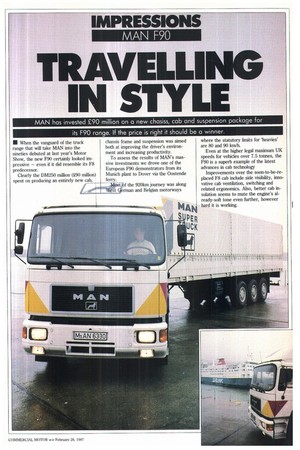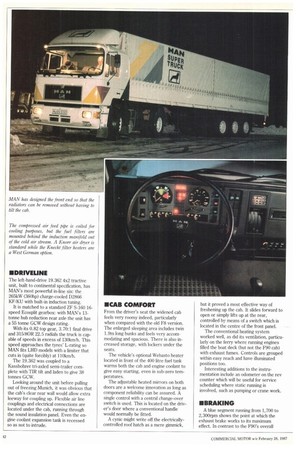TRAVELLING IN STYLE
Page 43

Page 44

Page 45

If you've noticed an error in this article please click here to report it so we can fix it.
MAN has invested £90 million on a new chasiss, cab and suspension package for its F90 range. If the price is right it should be a winner.
• When the vanguard of the truck range that will take MAN into the nineties debuted at last year's Motor Show, the new F90 certainly looked impressive — even if it did resemble its F8 predecessor.
Clearly the DM250 million (£90 million) spent on producing an entirely new cab, chassis frame and suspension was aimed both at improving the driver's environment and increasing productivity. To assess the results of MAN's massive investments we drove one of the European F90 demonstrators from its Munich plant to Dover via the Oostende ferry.
ost f the 920km journey was along rrnan and Belgian motorways where the statutory limits for 'heavies' are 80 and 90 Ian/h.
Even at the higher legal maximum UK speeds for vehicles over 7.5 tonnes, the F90 is a superb example of the latest advances in cab technology Improvements over the soon-to-be-replaced F8 cab include side visibility, innovative cab ventilation, switching and related ergonomics. Also, better cab insulation seems to mute the engine's already-soft tone even further, however hard it is working.
INDRIVELINE
The left-hand-drive 19.362 4x2 tractive unit, built to continental specification, has MAN's most powerful in-line six: the 265kW (360hp) charge-cooled D2866 KF/KU with built-in induction tuning.
It is matched to a standard ZF S-160 16speed Ecosplit gearbox: with MAN's 13tonne hub reduction rear axle the unit has a 55 tonne GCW design rating.
With its 0.82 top gear, 3.70:1 final drive and 315/80R 22.5 radials the truck is capable of speeds in excess of 130km/h. This speed approaches the tyres' L-rating so MAN fits LHD models with a limiter that cuts in (quite forcibly) at 110km/h.
The 19.362 was coupled to a Kassbohrer tri-axled semi-trailer complete with TIR tilt and laden to give 38 tonnes GCW.
Looking around the unit before pulling out of freezing Munich, it was obvious that the cab's clear rear wall would allow extra leeway for coupling up. Flexible air line couplings and electrical connections are located under the cab, running through the sound insulation panel. Even the engine coolant expansion tank is recessed so as not to intrude.
MCAB COMFORT
From the driver's seat the widened cab feels very roomy indeed, particularly when compared with the old F8 version. The enlarged sleeping area includes twin 1.9m long bunks and feels very accommodating and spacious. There is also increased storage, with lockers under the seats.
The vehicle's optional Webasto heater located in front of the 400 litre fuel tank warms both the cab and engine coolant to give easy starting, even in sub-zero temperatures.
The adjustable heated mirrors on both doors are a welcome innovation as long as component reliability can be assured. A single control with a central change-over switch is used. This is located on the driver's door where a conventional handle would normally be fitted.
A cynic might write off the electricallycontrolled roof hatch as a mere gimmick, but it proved a most effective way of freshening up the cab. It slides forward to open or simply lifts up at the rear, controlled by means of a switch which is located in the centre of the front panel.
The conventional heating system worked well, as did its ventilation, particularly on the ferry where running engines filled the boat deck (but not the F90 cab) with exhaust fumes. Controls are grouped within easy reach and have illuminated positions too.
Interesting additions to the instrumentation include an odometer on the rev counter which will be useful for service scheduling where static running is involved, such as pumping or crane work.
MBRAKING
A blue segment running from 1,700 to 2,300rpm shows the point at which the exhaust brake works to its maximum effect. In contrast to the F90's overall high level of sophistication, the control button for this is located too far under the seat. During prolonged use on long downhill runs its awkward location makes it very uncomfortable to hold down.
It is hard to say how effective it is, because the left-hooker we tested has its exhaust brake connected via an electrical feed to the trailer brakes. When used it draws about 10% of the trailer's braking effort simultaneously, and on the long drags north of Munich it felt very effective. This is a fairly common arrangement on the Continent but is outlawed in the UK.
In concert with the unit's exhaust brake it was far better than any similar device tested so far. It felt about as effective as the 'Jake brake' that was fitted but only working on two cylinders of a Cumminsengined Seddon Atkinson 401 tested two years ago (CM. April 13, 1985).
• FUEL CONSUMPTION
To combat the low overnight temperatures experienced during our test the fuel tank carried a 25% petro1/75% diesel mix, so although the truck has a flowmeter fitted it is really impossible to determine the 19.362's fuel efficiency. Suffice to say it covered the 920km on a single tankful with some left over.
• PERFORMANCE
On performance the induction tuned engine lived up to its growing reputation.
At motorway speeds the 19.362 pulled 38 tonnes effortlessly at between 1,400 and 1,500rpm, using its generous 1,500Nm spread of torque to good effect.
Only the long awkward throws of the Ecosplit's gearlever seemed out of tune with a gearbox that provided such well spaced-out ratios.
• HANDLING
With its long, wide parabolics at the front, improved air suspension at the rear and the cab's four-point springing it is hardly surprising that the ride was extremely quiet.
It was a fairly stable one too, apart from a gentle nodding of the cab on some of the trunk roads we encountered to the north-west of Cologne.
A time-sapping diversion caused by freezing fog and a horrific pile-up on the E.5 pushed us onto minor roads. Here a hasty U-turn underlined the extra-light touch of ZF's new 8098 Servocom powered-steering, which offers superb manoeuvrability.
On smooth, twisty A-roads, however, it seemed just a little over-sensitive and could do with more feedback at the steering wheel.
• BRITISH SPECIFICATION
While much of the 19.362 driveline is already familiar to UK operators, there will be a number of significant changes to the 'Euro-spec'. The first F90 models, which go on sale in Britain next month, will be the 16.362 4x2, closely followed by the 16.332. Both will be on the shorter 3.2m wheelbase.
With 640mm between the front axle and back of the cab the MAN will accommodate kingpin settings between 900 and 1,215mm on most 12.2m semi-trailers without any overloading problems.
Air suspension will be standard and steel optional (the reverse applies for the 16.332unit).
MAN huh-reduction axles will be fitted with 295/80R 22.5 tyres, which will allow a 7.5 tonne-11 tonne front and rear axle weight spread.
A 4.04:1 final drive will be standard but there will he a choice of 4.20 and 4.64:1 differentials.
Early RHD 16.362s will have the ZF Ecosplit, but MAN is well aware of the growing popularity in the UK of Eaton's Twin Splitter box and intends to add it to the optional TS0 11612 constant-mesh Unit later this year.
MAN will continue to offer the ABS (Anti-Block System) as an option, albeit an expensive one.
On UK models Eberspacher in-cab heaters will become standard, but the more expensive Webasto model can be fitted on demand.
MAN also intends to fit the Lucas Keinzle top speed limiter as standard to 16.362 and 16.332 models and may well include it further down the F90 range. Taking the Ecosplit's 0.82 top ratio and 4.04 final drive into account, the overall gearing on 295/80R 22.5s produces
67.4Icrn/h per 1,000ipii I. An alternative 3.7:1 differential is available but with the Twin Splitter's higher 0.78:1 top cog the maximum speed engine-rpm can be lowered by about 200rpm and is too large a step for general use.
Despite the impressive torque plateau of the D2866 KF/KL engine and its renowned flexibility, MAN customers should therefore tread warily when considering their choice of drivelines.
• SUMMARY
Without doubt the new F90 models combine a high level of driver comfort with good performance.
While MAN has settled its prices for continental Europe, it has yet to finalise its detailed specifications and pricing levels for right hand drive models.
Sophisticated engineering costs money, and MAN has to be sure of achieving that fine balance between its own strong currency and the danger of pricing itself out of the lucrative fleet market.
















































































































